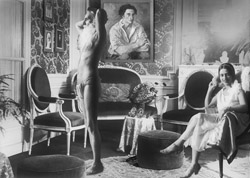

 Not everybody has the capability to re-stage a chapter of modern art history using family archives as their starting-point, but Vivan Sudaram, in his Re-Take of Amrita series, has done precisely that. Beginning with a trove of archival modern-era photographic portraits taken of his stunningly photogenic aunt, Amrita Sher-Gil, by his grandfather, Umrao Singh Sher-Gil, Sundaram has re-staged each photo in a way that allows family members to intersect with themselves and each other in places and times that would have been impossible during their lifetimes. That Amrita also happened to be a pioneering Indian modernist painter who died in 1941 in her late twenties reveals, among other things, that her nephew, born two years later, would never know her personally, although her likeness, not to mention her paintings, no doubt populated young Vivan’s childhood.
Not everybody has the capability to re-stage a chapter of modern art history using family archives as their starting-point, but Vivan Sudaram, in his Re-Take of Amrita series, has done precisely that. Beginning with a trove of archival modern-era photographic portraits taken of his stunningly photogenic aunt, Amrita Sher-Gil, by his grandfather, Umrao Singh Sher-Gil, Sundaram has re-staged each photo in a way that allows family members to intersect with themselves and each other in places and times that would have been impossible during their lifetimes. That Amrita also happened to be a pioneering Indian modernist painter who died in 1941 in her late twenties reveals, among other things, that her nephew, born two years later, would never know her personally, although her likeness, not to mention her paintings, no doubt populated young Vivan’s childhood.
The family ghosts that digital scanning and photo manipulation have enabled Sundaram to bring back to life have little if anything in common with spirits of the dearly departed who wander the drafty hallways of their descendents’ musty homes. Quite the contrary: Amrita’s and Umrao’s lives laid the stage for Sundaram’s own artistic mission, and by incorporating his grandfather’s photographs and his aunt’s legendary beauty into his own art, he unabashedly locates himself both within the historical nexus of modern and postmodern artistic practice, and as the inheritor of an important artistic legacy.
The complex layering of identities -- artistic, familial and ethnic -- provides the visual dynamic for Re-Take of Amrita. Sundaram’s grandfather met Amrita’s mother, a Hungarian opera singer, in Lahore in 1910, shortly after his first wife died, and following their marriage the couple moved to Budapest so that the children could be born there. Umrao had long made photographs, both before and after he and his family’s Hungarian sojourn, but it was not until the family moved from India to Paris in 1929, to support Amrita’s studies at the Ecole des Beaux Arts, that as a photographer he really came into its own.
With this complex family history as backdrop, Re-take of Amrita functions as a visual hall of mirrors in which these and other family members and their likenesses – throughout his lifetime Umrao regularly photographed himself in a loincloth, while Amrita painted a large number of self-portraits – appear in incongruous settings, or as chronologically shuffled versions of themselves. In fact, the mirror is probably the dominant visual motif of the whole series, as Sundaram’s appropriated subjects gaze ambivalently at their own reflections, and siblings and parents peer invisibly over their shoulders, at us.